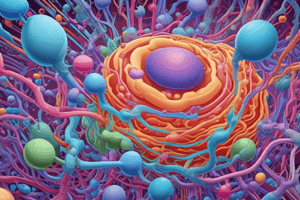Podcast
Questions and Answers
What characterizes peripheral membrane proteins?
What characterizes peripheral membrane proteins?
- They are permanently embedded in the lipid bilayer.
- They can only be removed by non-polar reagents.
- They are attached through non-covalent interactions. (correct)
- They function independently of the lipid bilayer.
Which of the following is NOT a primary function of membrane proteins?
Which of the following is NOT a primary function of membrane proteins?
- Energy production (correct)
- Transport
- Cell-cell recognition
- Cell signaling
How do integral proteins typically associate with the lipid bilayer?
How do integral proteins typically associate with the lipid bilayer?
- By crossing the bilayer in various structural forms. (correct)
- Through covalent attachment to lipid molecules.
- By forming temporary bonds with peripheral proteins.
- By extending only on the outer surface of the bilayer.
Which statement about peripheral proteins is accurate?
Which statement about peripheral proteins is accurate?
What type of protein would you expect to interact with the cytoskeleton for structural stability?
What type of protein would you expect to interact with the cytoskeleton for structural stability?
Which structure do transmembrane proteins NOT possess?
Which structure do transmembrane proteins NOT possess?
What role do membrane enzymes play in cell function?
What role do membrane enzymes play in cell function?
Which method is primarily used by proteins for anchoring in the lipid bilayer?
Which method is primarily used by proteins for anchoring in the lipid bilayer?
What defines integral membrane proteins?
What defines integral membrane proteins?
Which type of integral membrane protein spans the entire membrane?
Which type of integral membrane protein spans the entire membrane?
Which of the following best describes peripheral membrane proteins?
Which of the following best describes peripheral membrane proteins?
Lipid-anchored proteins are characterized by what feature?
Lipid-anchored proteins are characterized by what feature?
How do integral membrane proteins typically interact with the lipid bilayer?
How do integral membrane proteins typically interact with the lipid bilayer?
Which property is characteristic of transmembrane proteins?
Which property is characteristic of transmembrane proteins?
In the context of membrane-enzyme interactions, what is a key function of peripheral membrane proteins?
In the context of membrane-enzyme interactions, what is a key function of peripheral membrane proteins?
Which statement is true about the movement of integral membrane proteins?
Which statement is true about the movement of integral membrane proteins?
What characterizes transmembrane lipid-anchored proteins?
What characterizes transmembrane lipid-anchored proteins?
Which type of protein structure can form stable transmembrane domains?
Which type of protein structure can form stable transmembrane domains?
What is a primary function of peripheral proteins in membranes?
What is a primary function of peripheral proteins in membranes?
What distinguishes lipid-anchored proteins from transmembrane proteins?
What distinguishes lipid-anchored proteins from transmembrane proteins?
Which of the following enzymes is a type of peripheral membrane protein?
Which of the following enzymes is a type of peripheral membrane protein?
What mechanism allows proteins to cross biological membranes in a stable manner?
What mechanism allows proteins to cross biological membranes in a stable manner?
How do lipid-anchored proteins relate to the membrane's structural integrity?
How do lipid-anchored proteins relate to the membrane's structural integrity?
Which property describes the anchoring mechanism of lipid-anchored proteins?
Which property describes the anchoring mechanism of lipid-anchored proteins?
Study Notes
Peripheral Membrane Proteins
- Temporarily attached to the lipid bilayer or integral proteins via hydrophobic and electrostatic interactions.
- Dissociate upon treatment with polar reagents such as elevated pH or high salt concentrations.
- Can undergo post-translational modifications, including the addition of fatty acid chains.
Functions of Membrane Proteins
- Transport: Maintain ion concentrations and facilitate movement across the membrane.
- Enzymatic Activity: Produce essential substances for cellular function.
- Cell Signaling: Act as receptors for external signals.
- Cell-Cell Recognition: Allow cells to identify and interact with each other.
- Intercellular Joining: Facilitate adhesion between cells.
- Attachment: Connect to the cytoskeleton and extracellular matrix.
Types of Membrane Proteins
- Integral Membrane Proteins: Permanently embedded in the lipid bilayer, requiring detergents for displacement.
- Polytopic Proteins: Span the entire membrane (transmembrane).
- Monotopic Proteins: Attached from one side without spanning the membrane.
Properties of Integral Membrane Proteins
- Amphipathic structure with hydrophobic regions embedded in the bilayer and hydrophilic regions extending outward.
- Firmly bind through hydrophobic interactions but are not fixed, allowing some movement within the membrane.
- Require detergents for solubilization and include single or multipass membrane-spanning domains.
Structural Conformation of Transmembrane Proteins
- Cross the membrane predominantly via:
- Alpha Helix: Forms stable single-pass or multiple-pass structures.
- Beta-Barrel: Composed of strands satisfying hydrogen bonding, creating a channel through the membrane.
Categories of Peripheral Proteins
- Cytoskeletal Proteins: Maintain cell shape and anchor soluble proteins (e.g., spectrin, actin).
- Enzymes: Water-soluble enzymes associating with the polar head groups of phospholipids, including protein kinases, phospholipases, and cholinesterases.
- Phospholipase C hydrolizes bonds in phospholipid head groups.
Lipid-Anchored Proteins
- Covalently integrated within the membrane structure, attached to lipid tails.
- Exist on the cell membrane's surface, fulfilling critical structural and functional roles.
Studying That Suits You
Use AI to generate personalized quizzes and flashcards to suit your learning preferences.
Related Documents
Description
Explore the essential concepts of peripheral and integral membrane proteins in biochemistry. This quiz covers their characteristics, interactions, and the effects of various treatments on their stability. Test your understanding of membrane protein dynamics and their role within the cell.




